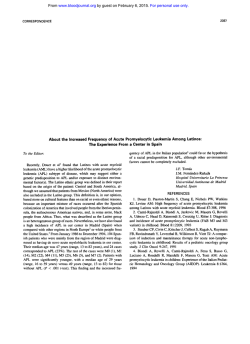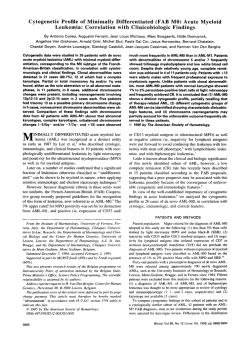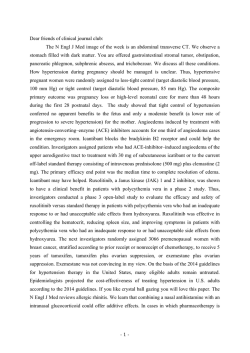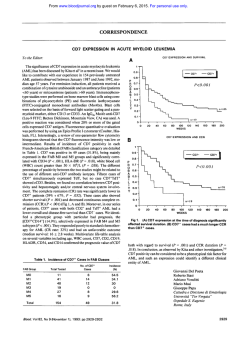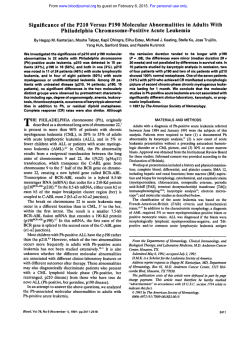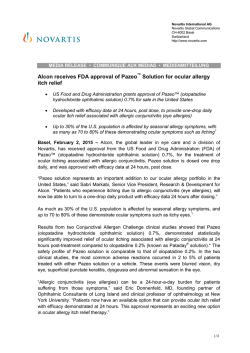
PDF (163 kB) - Immunology And Allergy Clinics of North America
Acute Urticaria Ruth A. Sabroe, FRCP, MD KEYWORDS Acute urticaria Anaphylaxis Antihistamines KEY POINTS Acute urticaria is common in adults and children. Acute urticaria is most often idiopathic, but it may follow infection, exposure to drugs, or less commonly food ingestion. Acute urticaria may be a presenting symptom of anaphylaxis. Acute urticaria by definition resolves within 6 weeks, but it often settles within 2 to 3 weeks. It may recur in a small proportion of patients. Acute urticaria may be treated with antihistamines or oral steroids if needed. INTRODUCTION Urticaria consists of transient red itchy swellings, or weals. Swellings are variable in size and usually last for less than 24 hours. Acute urticaria is defined as the occurrence of weals for less than 6 weeks, after which the disease instead becomes chronic urticaria.1 Acute urticaria is common, and presents in all age groups.2–4 Its transient and usually benign nature means that it may not come to the attention of doctors. Thus, the incidence may be underestimated, typical disease severity may be overestimated, the proportion with causative factors is difficult to ascertain, and the response to treatment is difficult to quantify. Such problems are compounded because patients also present to various different specialties, including generalists, emergency departments, pediatricians, immunologists or allergists, and dermatologists. This situation may explain why there are few publications including large cohorts of patients specifically with acute urticaria. However, the following article summarizes current knowledge on the condition. EPIDEMIOLOGY Acute urticaria is common in both adults and children. Indeed, it is one of the most common dermatologic conditions presenting to many emergency departments.3,5,6 Disclosures/Conflict of Interest: None. Department of Dermatology, Royal Hallamshire Hospital, Sheffield Teaching Hospitals NHS Foundation Trust, Glossop Road, Sheffield S10 2JF, UK E-mail address: [email protected] Immunol Allergy Clin N Am 34 (2014) 11–21 http://dx.doi.org/10.1016/j.iac.2013.07.010 immunology.theclinics.com 0889-8561/14/$ – see front matter Ó 2014 Elsevier Inc. All rights reserved. 12 Sabroe Overall, 12% to 22% of the general population will suffer from at least one subtype of urticaria at some time in their lives,7–9 with a prevalence of 0.11% to 0.6%.10,11 Of all patients with urticaria, only a low proportion of 7.6% to 16% have acute urticaria,12–14 although in one study the percentage was much higher at 56%.15 The variation may be related to the population studied and the interests of the department or doctor to whom patients are referred. The age group studied may be particularly important, because acute urticaria seems to be more common than chronic disease in very young children. Indeed, in one report, all children presenting at less than age 6 months had acute urticaria, and 85% of children less than age 2 years had this subtype.16 In older children, the ratio of chronic to acute urticaria seems to be similar to that in adults.17–19 The overall age range for presentation with acute urticaria is wide, in one study 3 months to 88 years,2 with an average in the early twenties.2–4 Most,2–4 but not all,15 reports find a female preponderance of about 60%. However, in young children the male to female ratio may be roughly equal.20–22 ETIOLOGY Attacks of acute urticaria are thought to be idiopathic in 30% to 50% of cases.2,15,23,24 Otherwise attacks may be triggered by infections, drugs, or foodstuffs (Table 1). The relative proportion of patients with each precipitant varies from study to study. In children, many studies find respiratory tract and other infections to be the most common trigger for urticaria.22,24,25 The association with respiratory tract infections may be related to a seasonal variation in incidence.25 Infections, of many types Table 1 Some of the reported causes of acute urticaria Cause Reference Idiopathic 2,15,23,24 Infection Viral Bacterial Other Adenovirus “Common cold” Cytomegalovirus Enterovirus Epstein-Barr Hepatitis A, B, C Herpes simplex Influenza A Parvovirus B19 Respiratory syncytial virus Rotavirus Varicella/Zoster 26,56 Group A beta-hemolytic streptococcus Haemophilus influenzae Staphylococcus aureus 60,61 Anisakis simplex Blastocystis hominis Malaria Mycoplasma Scabies 33 4 57 26,56,57 26,57 56,58 57,59 57 57 26 26 26 62 62 63,64 65 57,66 15 (continued on next page) Acute urticaria Table 1 (continued) Cause Drugs Food Other Reference ACE inhibitors Antibiotics/anti-infective drugs, especially cephalosporins and penicillins Antihistamines Anti-TNF alpha drugs Aspirin and other nonsteroidal antiinflammatory drugs Blood products Candesartan Epidural hyaluronidase Gadolinium-containing radiocontrast media Intravenous immunoglobulins Iodine-based contrast agents, eg, iopromide Isotretinoin Methylprednisolone (oral) Opiates and tramadol Paracetamol Proton pump inhibitors Vaccination 67 Cow’s milk Egg Fish and seafood Fruit, eg, peach and kiwi Nuts Tomato and other vegetables Wheat Yeast 16,17,24,26,82 “Gomutra” (cow’s urine) gargle Hedgehog spines Insect bites or stings Latex Systemic lupus erythematosus Thyroid papillary carcinoma or other thyroid disease 83 3,4,15,23,24,26,29,30,32 68 69 3,4,15,24,26,30,53 70,71 23 72 73 74 3,75 76 77 53,78 29,49,53 79 2,80,81 24,26 3,17 12,24,26 12,24,26 12,17 19 23 84 2–4,15,23,24 12,26 34 23,85 (see Table 1), may also be associated with urticaria in adults.2,4 However, it may be difficult to know if the urticaria was due to the infection itself or the drug used to treat it.2,4,16,24,26 Urticaria/angioedema is one of the most common types of drug-induced rash, and has been reported to account for 11.3% and 16.6% of drug eruptions in hospitalized patients aged 13 to 88 years and children, respectively.27,28 It may be more common for a drug eruption to be of an urticarial nature in younger patients.29 Urticaria may be more commonly drug induced in the elderly, especially due to nonsteroidal antiinflammatory drugs (NSAIDs).3 Overall, drugs are reported as being the cause of acute urticaria in 9.2% to 27% of cases.3,4 Multiple drugs have been implicated in acute urticarial reactions (see Table 1). In a recent study, 147 drugs were presumed to have caused attacks.30 However, the most common are antibiotics and NSAIDs.29,30 Reactions to one cephalosporin or one NSAID may or may not indicate crossreactivity with other drugs in the same group.31,32 Various foodstuffs have been reported as causing urticaria (see Table 1). In children younger than 6 months, cow’s milk allergy may be important.16 However, generally 13 14 Sabroe food is implicated less often in more recent reports, with estimates of causality ranging from 0% to 18% of cases.2–4,24 Some other causes of acute urticaria are listed in Table 1, and include contact with latex,12 insect bites or stings,2,3,15,23 ingestion of the fish nematode Anisakis simplex,33 and rarely acute urticaria may occur as part of a systemic disease such as systemic lupus erythematosus.34 Acute contact urticaria is not covered in this article. DISEASE MECHANISMS The mechanism for mast cell degranulation in acute urticaria is not always understood. In some cases, acute urticaria is due to a type I hypersensitivity reaction, in which case the urticaria may occur alone or as part of an anaphylactic reaction. A broad range of allergens may trigger urticaria in this way, including some antibiotics, latex, foodstuffs such as peanuts or tomatoes, and insect stings.12 However, type I hypersensitivity reactions are now thought to be less common than before as an etiologic factor in acute urticaria.4,24 Other mechanisms are thought to be involved in mast cell degranulation in urticaria induced by opiates, angiotensin-converting enzyme (ACE) inhibitor, and NSAIDs. Opiates trigger mast cell degranulation independent of IgE receptor activation.35 ACE inhibitor-induced urticaria may be due to elevated levels of bradykinin.36 In NSAID-induced urticaria, the arachidonic acid pathway is implicated, possibly with an inhibition of prostaglandin synthesis and an increase in leukotrienes.37 There may be a genetic tendency for patients to develop aspirin sensitivity. Indeed, several promoter polymorphisms have been identified, such as in TBXA2R (the thromboxane A2 receptor) gene,38 in the genes of aspirin-metabolizing enzymes,39 and in other genes encoding enzymes and receptors of the arachidonic acid pathway.40 In aspirin sensitivity, promoter polymorphisms have also been identified in some cytokine genes, including IL-18,41 IL-10,42 and TNFa.43 CLINICAL FEATURES During an attack of acute urticaria, weals are variable in number and size. More than 50% of the body surface area may be involved, and in one study the rash was described as generalized in 48% patients.3,4 Urticarial weals may occur alone or with angioedema. Coexistent angioedema has been reported in 16% to 31% of patients3,23 but may be more common in children younger than 3 years (60%) who may also get hemorrhagic weals.16,26 Systemic symptoms occur in up to a quarter of patients.23 Wheezing, breathlessness, cough, rhinorrhea, dizziness, flushing, gastrointestinal upset (nausea, vomiting, diarrhea, or abdominal pain), headache, fever, tachycardia, joint pain, or conjunctivitis can occur with an attack of acute urticaria.3,4 Such symptoms may indicate anaphylaxis if of rapid onset. DIFFERENTIAL DIAGNOSIS The key feature distinguishing urticaria from other rashes is the transient nature of the weals, and this usually makes it easy to diagnose within 24 to 36 hours. In addition, weals usually do not blister or form scales and disappear without residual changes. A detailed review of the differential diagnoses was published in 2010.44 The differential diagnosis includes the following: Erythema multiforme. Urticarial weals can sometimes clear centrally and spread out, giving an annular appearance. However, true target lesions do not occur in Acute urticaria urticaria, and the lesions of erythema multiforme persist for several days in the same place, sometimes with central blisters and sometimes with associated mucous membrane erosions. Toxic erythema. The lesions of a toxic erythema may be urticated and so initially confused with urticaria, but the lesions are usually symmetric, and remain fixed in the same place for several days. Acute eczema or acute contact dermatitis. Eczema may be red and swollen, but unlike urticaria it is associated with epidermal changes (weeping or vesicle formation followed by scaling) and takes a few days to settle. Autoimmune bullous diseases. Prodromal lesions may be urticarial or urticated. Polymorphic eruption of pregnancy. This condition may present with urticated lesions, but the distribution on stretch marks on the abdomen and duration of the lesions, which again are more prolonged than in urticaria, should distinguish the two. Cellulitis or erysipelas. These can be confused with large urticarial weals, but involved areas are unilateral, persistent and painful and the patient may be pyrexial and unwell. Similarly, in Well’s syndrome or eosinophilic cellulitis, the areas of redness persist, and here a skin biopsy may aid diagnosis. Progesterone-induced dermatosis. Here, weals recur premenstrually. Urticarial vasculitis. Prolonged urticarial weals followed by bruising may suggest urticarial vasculitis, especially if associated with systemic symptoms. A skin biopsy should then be taken to look for features suggestive of urticarial vasculitis, such as red cell extravasation, endothelial cell swelling, leukocytoclasia, and rarely fibrinoid necrosis.45 Systemic lupus erythematosus. Urticaria or urticarial vasculitis may occur as a presenting feature of systemic lupus erythematosus, and so if other suspicious features are present, an autoimmune screen should be performed. Scrombroid fish poisoning. Acute urticaria may be a presenting symptom.46 INVESTIGATIONS In many cases no investigations, other than a thorough history, are required (Box 1).47 Overinvestigation should be avoided. Sometimes a full blood count may be helpful, as alterations in the differential white cell count may indicate infection. An elevated C-reactive protein (CRP) level and/or erythrocyte sedimentation rate may point toward an infective or inflammatory cause, and the CRP level may also be elevated in NSAID-induced urticaria.48 Box 1 Investigations to consider Thorough history ? Nothing else Full blood count, with differential white cell count CRP level and/or erythrocyte sedimentation rate Culture relevant specimens Serum allergen-specific IgE tests Prick tests Oral drug challenge tests 15 16 Sabroe Relevant samples should be sent for culture if infection is suspected. If indicated, serum allergen-specific immunoglobulin E tests and/or prick tests may be used to investigate suspected type 1 hypersensitivity reactions.47 To minimize risks of misinterpretation of false-positive and false-negative test results, careful correlation of exposure history and relevant ancillary allergic history is required. It may be difficult to work out which drug if any was causative, particularly if several were given, or if drugs were given after an infection that might itself have caused the urticaria. On occasion, progression to skin prick or intradermal tests or structured oral drug challenge tests in a qualified immunology unit or expert center may be needed to correctly identify any culprit drugs and make relevant plans for possible future exposures.31 Oral drug challenge tests may also be helpful in defining crossreactivity between similar drugs.31,32,49 MANAGEMENT In mild cases, treatment may not be required (Box 2). However, if an infection is present, this should be treated appropriately. Causative drugs should be withdrawn and known allergens avoided. Topically, 1% to 2% menthol in aqueous cream may be helpful to reduce itching.50 If further treatment is needed, H1 receptor antagonists are usually introduced first.47,51 Low sedating drugs are preferable, but if the patient is still unable to sleep, then sedating drugs, particularly hydroxyzine, may be beneficial for a short period.2,4,52 The patient should be warned that such drugs may slow reactions when driving, even if they are not feeling sedated. Some patients known to develop urticaria after taking NSAIDs may be able to tolerate them if an antihistamine, or an antihistamine and a leukotriene receptor antagonist such as montelukast, is given beforehand.53,54 For severe urticaria, particularly if associated with angioedema or marked systemic symptoms, and provided infection is ruled out or treated, oral corticosteroids may be given for a few (3–5) days. Fairly high doses, up to 20 to 50 mg daily of prednisolone, are sometimes needed. Oral corticosteroids may shorten the duration of an attack and reduce symptom severity.4,52 If the urticaria is part of an anaphylactic reaction, then national guidelines and local protocols for anaphylaxis should be followed.55 Intramuscular adrenaline, intravenous antihistamines, intravenous corticosteroids, oxygen, salbutamol, fluid replacement, and other supportive treatment may be needed. Box 2 Management options to consider ? No treatment Stop causative drugs Avoid relevant allergens Treat infection Menthol, 1% to 2%, in aqueous cream H1 antihistamines Oral corticosteroids Treatment of anaphylaxis according to guidelines Medic alert bracelet Self-injectable adrenaline Acute urticaria Medic Alert bracelets may be recommended if there is a confirmed type 1 hypersensitivity reaction, particularly if the urticaria has occurred as part of an anaphylactic reaction. In the latter case, self-injectable adrenaline may be carried provided the patient has been shown how to use it and is capable and willing to do so.55 PROGNOSIS Most attacks of acute urticaria settle within 2 to 3 weeks.2,4,22 In a study of 1075 children with urticaria, disease duration was shortest for infants and adolescents, but more prolonged attacks were associated with having an atopic background, an infective cause, or the presence of systemic symptoms.22 This study also reported an association between short attack duration and the presence of angioedema. However, this finding was probably explained by the fact that children with angioedema were treated more aggressively, because the authors also found that aggressive management decreased episode length.22 Attacks may recur, particularly if the patient is inadvertently exposed to the same allergen or culprit drug. The percentage of children developing a second episode or chronic disease has been variously reported as 20% to 30% in 2 years26 or 3.5% to 5% in 8 years.21 In one study, 12% of 109 patients aged 5 to 86 years reported an attack of acute urticaria in the 10 years preceding the presenting episode, again indicating the possibility of recurrent episodes.4 None of the patients in this study went on to develop chronic disease, but the follow-up period was only 8 weeks. In another study of 50 patients aged 3 months to 88 years, 5 patients went into remission at 3 months and 2 patients had disease for more than 1 year.2 Overall, there are few reports documenting the proportion of patients progressing from acute to chronic disease. SUMMARY Acute urticaria is common in adults and children. It is a self-limiting condition, defined by its resolution within 6 weeks, although it usually disappears within 2 to 3 weeks. However, it may be recurrent and can progress to chronic disease. It is most often idiopathic but can be triggered by infection, drugs, and less frequently by foodstuffs. Although acute urticaria can occur as part of a type I hypersensitivity reaction, and sometimes as part of anaphylaxis, the mechanism leading to mast cell release is often unknown. The diagnosis is usually straightforward because of the transient nature of the urticarial weals, but it can be confused with several other conditions, especially in the first 24 hours. Investigations may be unnecessary. Management is aimed at removing or treating any cause, and symptom control, usually with H1 antihistamines. Anaphylaxis should be treated according to current guidelines. REFERENCES 1. Zuberbier T, Asero R, Bindslev-Jensen C, et al. EAACI/GA(2)LEN/EDF/WAO guideline: definition, classification and diagnosis of urticaria. Allergy 2009;64: 1417–26. 2. Aoki T, Kojima M, Horiko T. Acute urticaria: history and natural course of 50 cases. J Dermatol 1994;21:73–7. 3. Simonart T, Askenasi R, Lheureux P. Particularities of urticaria seen in the emergency department. Eur J Emerg Med 1994;1:80–2. 4. Zuberbier T, Iffla¨nder J, Semmler C, et al. Acute urticaria: clinical aspects and therapeutic responsiveness. Acta Derm Venereol 1996;76:295–7. 17 18 Sabroe 5. Wang E, Lim BL, Than KY. Dermatological conditions presenting at an emergency department in Singapore. Singapore Med J 2009;50:881–4. 6. Grillo E, Vano-Galvan S, Jimenez-Gomez N, et al. Dermatologic emergencies: descriptive analysis of 861 patients in a tertiary care teaching hospital. Actas Dermosifiliogr 2013;104:316–24. 7. McKee WD. The incidence and familial occurrence of allergy. J Allergy 1966;38: 226–35. 8. Sheldon JM, Mathews KP, Lovell RG. The vexing urticaria problem: present concepts of etiology and management. J Allergy 1954;25:525–60. 9. Swinny B. The atopic factor in urticaria. South Med J 1941;34:855–87. 10. Gaig P, Olona M, Munoz Lejarazu D, et al. Epidemiology of urticaria in Spain. J Investig Allergol Clin Immunol 2004;14:214–20. 11. Hellgren L. The prevalence of urticaria in the total population. Acta Allergol 1972;27:236–40. 12. Nettis E, Pannofino A, D’Aprile C, et al. Clinical and aetiological aspects in urticaria an angio-oedema. Br J Dermatol 2003;148:501–6. 13. Humphreys F, Hunter JA. The characteristics of urticaria in 390 patients. Br J Dermatol 1998;138:635–8. 14. Nizami RM, Baboo MT. Office management of patients with urticaria: an analysis of 215 patients. Ann Allergy 1974;33:78–85. 15. Sehgal VN, Rege VL. An interrogative study of 158 urticaria patients. Ann Allergy 1973;31:279–83. 16. Legrain V, Taieb A, Sage T, et al. Urticaria in infants: a study of forty patients. Pediatr Dermatol 1990;7:101–7. 17. Kauppinen K, Juntunen K, Lanki H. Urticaria in children. Retrospective evaluation and follow-up. Allergy 1984;39:469–72. 18. Ghosh S, Kanwar AJ, Kaur S. Urticaria in children. Pediatr Dermatol 1993;10: 107–10. 19. Sackesen C, Sekerel BE, Orhan F, et al. The etiology of different forms of urticaria in childhood. Pediatr Dermatol 2004;21:102–8. 20. Liu TH, Lin YR, Yang KC, et al. First attack of acute urticaria in pediatric emergency department. Pediatr Neonatol 2008;49:58–64. 21. Haas N, Birkle-Berlinger W, Henz BM. Prognosis of acute urticaria in children. Acta Derm Venereol 2005;85:74–5. 22. Lin YR, Liu TH, Wu TK, et al. Predictive factors of the duration of a first-attack acute urticaria in children. Am J Emerg Med 2011;29:883–9. 23. Kulthanan K, Chiawsirikajorn Y, Jiamton S. Acute urticaria: etiologies, clinical course and quality of life. Asian Pac J Allergy Immunol 2008;26:1–9. 24. Ricci G, Giannetti A, Belotti T, et al. Allergy is not the main trigger of urticaria in children referred to the emergency room. J Eur Acad Dermatol Venereol 2010; 24:1347–8. 25. Konstantinou GN, Papadopoulos NG, Tavladaki T, et al. Childhood acute urticaria in northern and southern Europe shows a similar epidemiological pattern and significant meteorological influences. Pediatr Allergy Immunol 2011;22: 36–42. 26. Mortureux P, Leaute-Labreze C, Legrain-Lifermann V, et al. Acute urticaria in infancy and early childhood: a prospective study. Arch Dermatol 1998;134:319–23. 27. Lee HY, Tay LK, Thirumoorthy T, et al. Cutaneous adverse drug reactions in hospitalised patients. Singapore Med J 2010;51:767–74. 28. Khaled A, Kharfi M, Ben Hamida M, et al. Cutaneous adverse drug reactions in children. A series of 90 cases. Tunis Med 2012;90:45–50. Acute urticaria 29. Zhong H, Zhou Z, Wang H, et al. Prevalence of cutaneous adverse drug reactions in Southwest China: an 11-year retrospective survey on in-patients of a dermatology ward. Dermatitis 2012;23:81–5. 30. Rutnin NO, Kulthanan K, Tuchinda P, et al. Drug-induced urticaria: causes and clinical courses. J Drugs Dermatol 2011;10:1019–24. 31. Chaudhry T, Hissaria P, Wiese M, et al. Oral drug challenges in non-steroidal anti-inflammatory drug-induced urticaria, angioedema and anaphylaxis. Intern Med J 2012;42:665–71. 32. Pipet A, Veyrac G, Wessel F, et al. A statement on cefazolin immediate hypersensitivity: data from a large database, and focus on the cross-reactivities. Clin Exp Allergy 2011;41:1602–8. 33. Falcao H, Lunet N, Neves E, et al. Anisakis simplex as a risk factor for relapsing acute urticaria: a case-control study. J Epidemiol Community Health 2008;62: 634–7. 34. Cooper KD. Urticaria and angioedema: diagnosis and evaluation. J Am Acad Dermatol 1991;25:166–76. 35. Barke KE, Hough LB. Opiates, mast cells and histamine release. Life Sci 1993; 53:1391–9. 36. Caballero T, Baeza ML, Cabanas R, et al. Consensus statement on the diagnosis, management, and treatment of angioedema mediated by bradykinin. Part I. Classification, epidemiology, pathophysiology, genetics, clinical symptoms, and diagnosis. J Investig Allergol Clin Immunol 2011;21:333–47 [quiz follow: 347]. 37. Nettis E, Dambra P. Comparison of montelukast and fexofenadine for chronic idiopathic urticaria. Arch Dermatol 2001;137:99–100. 38. Palikhe NS, Kim SH, Lee HY, et al. Association of thromboxane A2 receptor (TBXA2R) gene polymorphism in patients with aspirin-intolerant acute urticaria. Clin Exp Allergy 2011;41:179–85. 39. Palikhe NS, Kim SH, Nam YH, et al. Polymorphisms of aspirin-metabolizing enzymes CYP2C9, NAT2 and UGT1A6 in aspirin-intolerant urticaria. Allergy Asthma Immunol Res 2011;3:273–6. 40. Cornejo-Garcia JA, Jagemann LR, Blanca-Lopez N, et al. Genetic variants of the arachidonic acid pathway in non-steroidal anti-inflammatory drug-induced acute urticaria. Clin Exp Allergy 2012;42:1772–81. 41. Kim SH, Son JK, Yang EM, et al. A functional promoter polymorphism of the human IL18 gene is associated with aspirin-induced urticaria. Br J Dermatol 2011;165:976–84. 42. Palikhe NS, Kim SH, Jin HJ, et al. Association of interleukin 10 promoter polymorphism at -819 T>C with aspirin-induced urticaria in a Korean population. Ann Allergy Asthma Immunol 2011;107:544–6. 43. Choi JH, Kim SH, Cho BY, et al. Association of TNF-alpha promoter polymorphisms with aspirin-induced urticaria. J Clin Pharm Ther 2009;34:231–8. 44. Peroni A, Colato C, Schena D, et al. Urticarial lesions: if not urticaria, what else? The differential diagnosis of urticaria: part I. Cutaneous diseases. J Am Acad Dermatol 2010;62:541–55 [quiz: 555–6]. 45. Mehregan DR, Hall MJ, Gibson LE. Urticarial vasculitis: a histopathologic and clinical review of 72 cases. J Am Acad Dermatol 1992;26:441–8. 46. Ward DI. ’Mass allergy’: acute scombroid poisoning in a deployed Australian Defence Force health facility. Emerg Med Australas 2011;23:98–102. 47. Grattan CE, Humphreys F. Guidelines for evaluation and management of urticaria in adults and children. Br J Dermatol 2007;157:1116–23. 19 20 Sabroe 48. Kasperska-Zajac A, Grzanka A, Czecior E, et al. Acute phase inflammatory markers in patients with non-steroidal anti-inflammatory drugs (NSAIDs)induced acute urticaria/angioedema and after aspirin challenge. J Eur Acad Dermatol Venereol 2013;27(8):1048–52. 49. Rutkowski K, Nasser SM, Ewan PW. Paracetamol hypersensitivity: clinical features, mechanism and role of specific IgE. Int Arch Allergy Immunol 2012;159: 60–4. 50. Bromm B, Scharein E, Darsow U, et al. Effects of menthol and cold on histamineinduced itch and skin reactions in man. Neurosci Lett 1995;187:157–60. 51. Zuberbier T, Greaves MW, Juhlin L, et al. Management of urticaria: a consensus report. J Investig Dermatol Symp Proc 2001;6:128–31. 52. Pollack CV Jr, Romano TJ. Outpatient management of acute urticaria: the role of prednisone. Ann Emerg Med 1995;26:547–51. 53. Asero R. Cetirizine premedication prevents acute urticaria induced by weak COX-1 inhibitors in multiple NSAID reactors. Eur Ann Allergy Clin Immunol 2010;42:174–7. 54. Nosbaum A, Braire-Bourrel M, Dubost R, et al. Prevention of nonsteroidal inflammatory drug-induced urticaria and/or angioedema. Ann Allergy Asthma Immunol 2013;110:263–6. 55. Simons FE, Ardusso LR, Bilo MB, et al. World Allergy Organization anaphylaxis guidelines: summary. J Allergy Clin Immunol 2011;127:587–93.e1–22. 56. Weston WL, Badgett JT. Urticaria. Pediatr Rev 1998;19:240–4. 57. Bilbao A, Garcia JM, Pocheville I, et al. Round table: urticaria in relation to infections. Allergol Immunopathol (Madr) 1999;27:73–85 [in Spanish]. 58. van Aalsburg R, de Pagter AP, van Genderen PJ. Urticaria and periorbital edema as prodromal presenting signs of acute hepatitis B infection. J Travel Med 2011;18:224–5. 59. Zawar V, Godse K. Recurrent facial urticaria following herpes simplex labialis. Indian J Dermatol 2012;57:144–5. 60. Schuller DE, Elvey SM. Acute urticaria associated with streptococcal infection. Pediatrics 1980;65:592–6. 61. Calado G, Loureiro G, Machado D, et al. Streptococcal tonsillitis as a cause of urticaria: tonsillitis and urticaria. Allergol Immunopathol (Madr) 2012;40:341–5. 62. Sakurai M, Oba M, Matsumoto K, et al. Acute infectious urticaria: clinical and laboratory analysis in nineteen patients. J Dermatol 2000;27:87–93. 63. Hameed DM, Hassanin OM, Zuel-Fakkar NM. Association of Blastocystis hominis genetic subtypes with urticaria. Parasitol Res 2011;108:553–60. 64. Zuel-Fakkar NM, Abdel Hameed DM, Hassanin OM. Study of Blastocystis hominis isolates in urticaria: a case-control study. Clin Exp Dermatol 2011;36:908–10. 65. Godse KV, Zawar V. Malaria presenting as urticaria. Indian J Dermatol 2012;57: 237–8. 66. Kano Y, Mitsuyama Y, Hirahara K, et al. Mycoplasma pneumoniae infectioninduced erythema nodosum, anaphylactoid purpura, and acute urticaria in 3 people in a single family. J Am Acad Dermatol 2007;57:S33–5. 67. Inman WH, Rawson NS, Wilton LV, et al. Postmarketing surveillance of enalapril. I: results of prescription-event monitering. Br Med J 1988;297:826–9. 68. Bobadilla-Gonzalez P, Perez-Rangel I, Camara-Hijon C, et al. Positive basophil activation test result in a patient with acute urticaria induced by cetirizine and desloratadine. Ann Allergy Asthma Immunol 2011;106:258–9. 69. de Moraes JC, Aikawa NE, Ribeiro AC, et al. Immediate complications of 3,555 injections of anti-TNFalpha. Rev Bras Reumatol 2010;50:165–75. Acute urticaria 70. Henderson RA, Pinder L. Acute transfusion reactions. N Z Med J 1990;103: 509–11. 71. Shemin D, Briggs D, Greenan M. Complications of therapeutic plasma exchange: a prospective study of 1,727 procedures. J Clin Apher 2007;22:270–6. 72. Kim JH, Choi GS, Ye YM, et al. Acute urticaria caused by the injection of goatderived hyaluronidase. Allergy Asthma Immunol Res 2009;1:48–50. 73. Dillman JR, Ellis JH, Cohan RH, et al. Frequency and severity of acute allergiclike reactions to gadolinium-containing i.v. contrast media in children and adults. AJR Am J Roentgenol 2007;189:1533–8. 74. Hamrock DJ. Adverse events associated with intravenous immunoglobulin therapy. Int Immunopharmacol 2006;6:535–42. 75. Palkowitsch P, Lengsfeld P, Stauch K, et al. Safety and diagnostic image quality of iopromide: results of a large non-interventional observational study of European and Asian patients (IMAGE). Acta Radiol 2012;53:179–86. 76. Saray Y, Seckin D. Angioedema and urticaria due to isotretinoin therapy. J Eur Acad Dermatol Venereol 2006;20:118–20. 77. Jang EJ, Jin HJ, Nam YH, et al. Acute urticaria induced by oral methylprednisolone. Allergy Asthma Immunol Res 2011;3:277–9. 78. Nasser SM, Ewan PW. Opiate-sensitivity: clinical characteristics and the role of skin prick testing. Clin Exp Allergy 2001;31:1014–20. 79. Chang YS. Hypersensitivity reactions to proton pump inhibitors. Curr Opin Allergy Clin Immunol 2012;12:348–53. 80. Humphreys F. Acute urticaria and angio-oedema following Haemophilus influenzae b vaccination. Br J Dermatol 1994;131:582–3. 81. Barbaud A, Trechot P, Reichert-Penetrat S, et al. Allergic mechanisms and urticaria/angioedema after hepatitis B immunization. Br J Dermatol 1998;139: 925–6. 82. Caffarelli C, Baldi F, Bendandi B, et al. Cow’s milk protein allergy in children: a practical guide. Ital J Pediatr 2010;36:5. 83. Bhalla M, Thami GP. Acute urticaria following ‘gomutra’ (cow’s urine) gargles. Clin Exp Dermatol 2005;30:722–3. 84. Fairley JA, Suchniak J, Paller AS. Hedgehog hives. Arch Dermatol 1999;135: 561–3. 85. Kartal O, Abdullah B, Ramazan E, et al. Acute urticaria associated with thyroid papillary carcinoma: a case report. Ann Dermatol 2012;24:453–4. 21
© Copyright 2025

